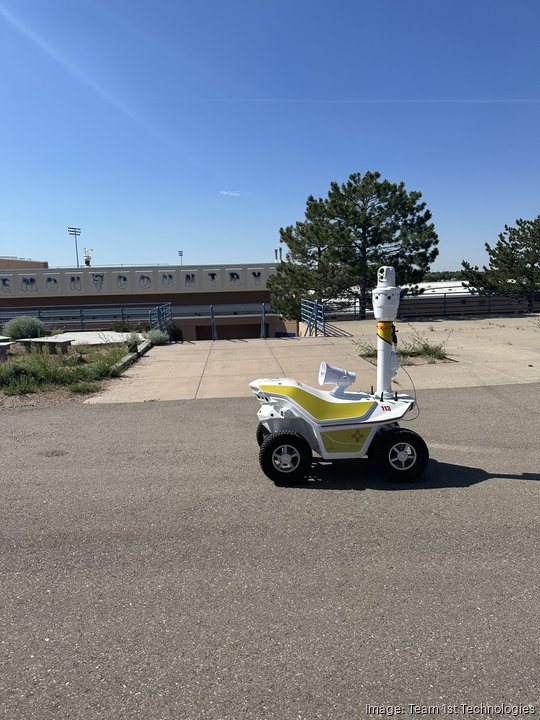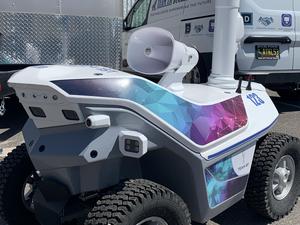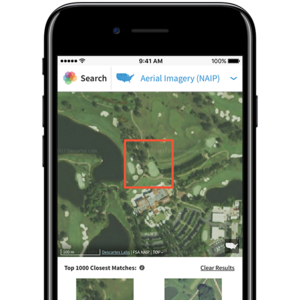
As a two-month trial run comes to a close, Santa Fe Public Schools appears ready to implement technology from an Albuquerque robotics company it thinks can help keep a pair of high school campuses safer.
In July, Team 1st Technologies, headquartered at 4500 Anaheim Ave. in Albuquerque, kicked off a 60-day trial at Santa Fe High School. That pilot, which is set to end Sept. 1, has seen one of the company's 300-plus pound, four-wheeled security robots patrol the school campus this summer.
It was the first time Team 1st deployed one of its bots at a school. And according to Mario Salbidrez, the executive director of school security for Santa Fe Public Schools, its success could lead to a pair of permanent deployments for the 2023-2024 school year.
Santa Fe Public Schools is considering using one of Team 1st's security robots full time at Santa Fe High School, and another at Capital High School. The district is short on security personnel, Salbidrez told Albuquerque Business First; the two bots could help fill staffing gaps, he said.
Those robots would cost the school district between $60,000 to $70,000 per bot for the academic year. While that range may seem steep, Salbidrez said it costs about $8 per hour for each bot for around-the-clock security when the total cost is broken down. He said the district has already identified a funding source.
The Santa Fe Public Schools Board of Education must approve any purchase over $60,000, Cody Dynarski, Santa Fe Public Schools' public information officer, said. The bots' use has to be approved by Superintendent Hilario Chavez before going in front of the board. That could happen as soon as late September, but Salbidrez said it's more likely board approval wouldn't come until October.
There are many different facets the school district has considered when deciding whether or not to move forward with the robots after the trial period. Those include seeing if the bot complements schools' existing security protocols, if it's effective at deterring potential threats and if the robot can scale with the district's security needs.
Salbidrez told Business First the robot has excelled on all fronts. For instance, he said the robot has helped keep people off the Santa Fe High School campus — a problem the school had before the trial.
"They don't understand the extent of the robot's capabilities," Salbidrez said about trespassers who come into contact with the bot. "It's been acting as a deterrent in that way."
Students and staff have reacted well to the robot, too, he said. Students have tried to interact with it, but it's usually "funny little quirky things" like waves or pats, Salbidrez said. He said a grandparent called to see if the district could equip the robot with a scarf.
Although the trial has proven the robots successful, Salbidrez said he doesn't want to implement the tech too quickly. The school district "wants to make sure we are as prudent as possible" in figuring out the best way to use the robots full time, he said.
Part of that includes how the robots' capabilities can expand with the district's security needs. Andy Sanchez, the channel partner manager for Team 1st Technologies who helped lead the Santa Fe trial, also highlighted the robots' expandability.
For example, he said, the school district requested the robot come with more space to store video footage. The company added more storage to meet that need.
"The robot was able to be around the students, not necessarily patrolling but moving to different locations and providing footage from different corners of the school campus," Sanchez said. "That's been the idea."
Team 1st can also change the robots' pre-programmed routes to reach more remote places. That can help the district address problem areas more quickly instead of having to wait for another company to come in and install cameras, which can take several days, Salbidrez, the school security director, said.
The robots provide a live video feed security officers can check anytime. The bots also notify officers of immediate security threats via smartphones for faster emergency response.
FirstNet, a public safety-focused communications network run by AT&T Inc., has provided cellular service to the robots via a partnership with Team 1st Technologies. That ensures the bots maintain service when required to respond to threats and notify security personnel immediately, Sanchez said.
Salbidrez said using the robots is one part of Santa Fe Public Schools' plans to adopt technology that meets different needs like staffing shortages. But it's not an all-purpose solution to the district's security, he said.
"This robot is not to replace any staff member or anyone already employed," Salbidrez said. "This robot is used to complement the work that we already do for safety and security. It adds layers of
protection to deter criminal activity."








